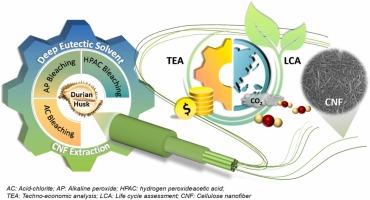生物质无氯预处理合成纳米纤维素的生命周期评价及技术经济分析
IF 7.8
2区 环境科学与生态学
Q1 ENGINEERING, CHEMICAL
引用次数: 0
摘要
纳米纤维素纤维(CNF)集纤维素和纳米材料的特性于一体,具有广阔的应用前景。在提取纳米纤维素之前,预处理生物质以去除木质素和半纤维素对于以最小的环境和经济成本缓解纤维素分离至关重要。本研究对酸性-亚氯酸盐(AC)、碱性过氧化氢(AP)和过氧化氢-乙酸(HPAC)处理进行了全面比较。实验数据作为生命周期评估(LCA)和技术经济分析(TEA)的主要输入,以评估所生产的CNFs的质量,并研究与三种漂白途径相关的环境负担和成本之间的权衡。FTIR和FESEM分析表明,无论采用何种漂白技术,CNF合成都是成功的。值得注意的是,由于产量低和使用化学品,CNF-AC在工业规模生产中生态效率最低。CNF-AP成为最环保的选择;然而,CNF-HPAC反应时间短,产率令人满意,耗电量低,环境负荷适中,是最具成本效益的。这项研究强调了HPAC技术在CNF生产中作为传统AC处理的替代方案的潜力。本文章由计算机程序翻译,如有差异,请以英文原文为准。

Life cycle assessment and techno-economic analysis of nanocellulose synthesis via chlorine-free biomass pretreatments
Nanocellulose fibers (CNF) encompass the characteristics of cellulose and nanomaterials, are endowed with great potential for diverse applications. Prior to the extraction of nanocellulose, pretreating biomass to remove lignin and hemicellulose is crucial to ease cellulose isolation at minimal environmental and economic costs. This study presents a comprehensive comparison between acid-chlorite (AC), alkaline peroxide (AP), and hydrogen peroxide-acetic acid (HPAC) treatments, revealing that the latter two total chlorine-free technologies are promising alternatives to AC. Experimental data served as the primary input to the life cycle assessment (LCA) and techno-economic analysis (TEA) to evaluate the quality of CNFs produced and investigate the trade-offs between environmental burden and costs associated with the three bleaching pathways. The FTIR and FESEM analyses showed a successful CNF synthesis regardless of the applied bleaching technique. Notably, CNF-AC was the least eco-efficient at industrial-scale production due to its low yield and the use of chemicals. CNF-AP emerged as the greenest option; however, CNF-HPAC was the most cost-effective with a moderate environmental load for its low electricity consumption, which resulted from the short reaction time required and satisfactory yield. This study highlighted the potential of HPAC technology as a promising alternative to conventional AC treatment in CNF production.
求助全文
通过发布文献求助,成功后即可免费获取论文全文。
去求助
来源期刊

Process Safety and Environmental Protection
环境科学-工程:化工
CiteScore
11.40
自引率
15.40%
发文量
929
审稿时长
8.0 months
期刊介绍:
The Process Safety and Environmental Protection (PSEP) journal is a leading international publication that focuses on the publication of high-quality, original research papers in the field of engineering, specifically those related to the safety of industrial processes and environmental protection. The journal encourages submissions that present new developments in safety and environmental aspects, particularly those that show how research findings can be applied in process engineering design and practice.
PSEP is particularly interested in research that brings fresh perspectives to established engineering principles, identifies unsolved problems, or suggests directions for future research. The journal also values contributions that push the boundaries of traditional engineering and welcomes multidisciplinary papers.
PSEP's articles are abstracted and indexed by a range of databases and services, which helps to ensure that the journal's research is accessible and recognized in the academic and professional communities. These databases include ANTE, Chemical Abstracts, Chemical Hazards in Industry, Current Contents, Elsevier Engineering Information database, Pascal Francis, Web of Science, Scopus, Engineering Information Database EnCompass LIT (Elsevier), and INSPEC. This wide coverage facilitates the dissemination of the journal's content to a global audience interested in process safety and environmental engineering.
 求助内容:
求助内容: 应助结果提醒方式:
应助结果提醒方式:


